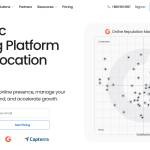You’ve worked hard to build your business, but maintaining relevance and market share is another beast entirely. To enjoy long-term success, you need to articulate your value, innovate often, and understand those you serve. Surprises will arise, but with these four key elements on your priority list, you can succeed and grow long-term.
1. Establish Your Value Proposition Online
What sets you apart may be obvious to you, but if you’re coined a “best-kept secret,” pay attention. Today’s business landscape is full of distracting, sensational claims of new, better, and best. If you’ve been operating in a word-of-mouth marketing world, it’s time to advance into the new age of marketing.
Customers largely look online for just about anything. If your company isn’t in the mix of results, the silence speaks loudly. Consider how you present your brand on your owned media, like your website and social media pages. What may be sufficient for existing customers may be doing you a disservice when it comes to new client acquisition.
For example, a law office may naturally provide an overview of practice areas, attorneys, and general case results. However, a large gap exists where valuable, relevant content can drive new clients in. Many people are searching for advice, answers, and help, especially when it comes to the law. Position your team as the subject matter experts they are, and create a company blog to further reinforce your expertise.
The more frequently your content appears, the better your firm’s site will rank when potential clients search. A growth marketing agency can help identify what content will build credibility, authority, and visibility to establish industry ownership. With your industry expertise and online presence, your value proposition rings clear.
2. Stay Ahead of Emerging Technology
No matter your industry, technology advances will eventually change how you do business. Instead of digging your heels into what’s always worked, be curious about what could be. Strive to embrace new technology and get curious about what ways it can help your business.
If your team fields customer service calls all day, consider how you can streamline their workflows. A well-designed interactive voice response or IVR allows callers to self-identify their call reason, which often reduces total call times. Review your recent call data to see if this technology could help ease the pressure on your team and improve satisfaction.
As real estate and labor become more expensive, outsourcing certain components of your business may make sense too. For instance, instead of managing inventory on-site, you can reconfigure your logistics to deliver on-demand for your main facility’s needs. If you’re shipping products to customers, you can outsource both warehousing and fulfillment. By embracing technology, you can streamline your operation and focus on value-added work.
3. Leverage Consumer Data
The competition today is fierce, but if you understand your customers, you can usually stay ahead of the game. Use your customer data to build experience-led journeys that lead to customer satisfaction, retention, and delight.
Connect customer data across platforms by using a customer relationship management system or CRM. This customer database blends client actions with experiences like email marketing, customer service, and sales. If a client browses online but doesn’t buy, you can follow up with a relevant reminder nudge via email. By paying attention to your clients’ behaviors, you’ll build better journeys that present high closure-rate buying opportunities.
Data garnered through your customers’ journey can make sense of their behavior, which you can then analyze. By using real customer data to develop campaigns, products, and innovations, you can improve your return on investment. This process allows you to create more accurate personas for your client types, which can guide where you invest. When you understand your customers better, you serve them better, which leads to loyalty and a healthier bottom line.
4. Build Customer Loyalty Through Gratitude
Everyone wants to feel appreciated, but gratitude often takes a back seat these days, especially in business. Differentiate your company by adopting a culture of gratitude inside and out. This can lead to improved morale amongst associates, which can boost productivity and service. With your clients, it can build loyalty, lead to referrals, and reveal cross-selling opportunities.
Recognize your team’s contributions and hard work in real time, offering feedback and validation. While you should ensure your compensation and benefits are appropriate for your industry, a good company culture pays dividends. Gratitude has been shown to reduce stress and improve moods, which offer benefits for everyone involved. In the workplace, this can increase trust among teammates and allow people to provide clients with the best service.
With clients, express gratitude for their loyalty and trust, no matter their invoice amount or tenure. Automate thank you messages after purchases online and include gratitude in your call center scripting. Align this practice with genuine appreciation in how you speak about your clients internally. Celebrate your clients’ wins along with them and express appreciation for entrusting your company to be a part of their journey.
Be In It for the Long Haul
Flexibility is the name of the game when it comes to long-term business success. Be willing to adapt, even when your business-veteran status compels you otherwise. Immerse yourself in your industry’s emerging technology, be curious about your client’s needs, and establish your value proposition widely. When you do, your company will experience positive growth for years.
Lynn Martelli is an editor at Readability. She received her MFA in Creative Writing from Antioch University and has worked as an editor for over 10 years. Lynn has edited a wide variety of books, including fiction, non-fiction, memoirs, and more. In her free time, Lynn enjoys reading, writing, and spending time with her family and friends.















